September 14, 2018 / admin / 0 Comments
Ladies, Gentlemen and Children of all ages…your dear old GrizzlyBearSims has managed to claw his way back to YouTube! The last time I recorded, edited and published a video the calendar still showed us in Spring and here we are three months later, I managed to at the very least get a video recorded, edited and uploaded while the calendar still shows Summer. I’m back and most importantly, I’m really glad to be back.
I started the GBS YouTube channel for one primary reason and that was to entertain and help others. I’ll admit that I often became somewhat sidetracked from my initial focus and allowed YouTube to somewhat take over my life. Before I realized this was happening, I was knee deep in a heavy work travel schedule and just had to put some distance between myself and the YouTube content creation work. But life has calmed down, we’re back from our Europe vacation and my batteries are mostly recharged.
Making Changes
As I discuss in the video which will release today, I’m returning to YouTube but a few things are going to change with how I operate. As previously mentioned, I already have a career and I’m not looking for a second one. So I’m going to return back to my roots of recording and producing content as a way of having fun and helping others. I’m throwing away the schedule concept as I’ve tried and failed multiple times to stick to a release schedule. Videos will be release when they are available. This might mean some weeks you may see one, two or perhaps even more and some weeks there may be none.
Shamrock Valley
I’m making my return to YouTube playing the new Shamrock Valley map. I like it, it reminds me of Thornton Farm and Coldborough Park Farm I suppose. I’m also playing this series without the Seasons Mod. I made the decision to omit the Seasons Mod from my game play this time around in an effort to prevent me from getting bored with the map too soon. We’ll see how it goes.
Join Me
I hope you’ll join me on this new adventure. I have some stories to catch you all up on my activities over the past three months and might even try to role play from time to time as well. But no promises. Let’s just do some farming on a beautiful map and enjoy the journey.
Please head over to the GrizzlyBearSims YouTube Channel, please click Subscribe if you are not a subscriber and enjoy the first video after my long summer hiatus. Also, please take a few minutes and visit the channels of my partners in crime Eustace Pharmer and DuckZorly Gaming. Finally, if you are a Discord user, check out the Simulation Gaming Society Discord where you’ll find lots of great conversation about Farming Simulator 17 and much more.
Until next time…
Happy Farming!
Jerry
September 12, 2018 / admin / 0 Comments
Hello to my wonderful and loyal readers. We’re back in the USA…well sort of. I’m writing this update before we actually left for vacation, but as my dad would say “The Good Lord willing and the creek don’t rise”, we should be back home, back to work and trying to figure out how to sleep through the night without waking up at 2 AM as you are reading this. It typically doesn’t take me very long to get back on my schedule. The first couple of days are a bit brutal and coffee, good strong coffee is usually the thing that keeps me going then once home I fight the urge to crash at 7 PM. After 2-3 days I’m back to my routines and all is once again right with the world.
When I began this tour waaaaaaayyyy back in early June, I really had no idea when it would wrap. I know I told you all that if I could make it wrap up around the time of the actual WorldFlight event I would. But with 46 flights, 36,000 miles and no telling how many hours…the target was a moving one at best. However, now that we’re past the half-way mark and now that I’ve actually managed to build up a queue of almost 5 weeks of flights, I have a pretty good idea when I can say this tour will end.
The actual WorldFlight 2018 begins on 3 November and wraps up a week later on 10 November. Now if I continue to release two flight updates each week, it means I’ll conclude my tour on 17 November (a week after the actual tour finishes). So my plan is simple. Once I get back from vacation, get over my jetlag and get caught up…I’ll increase my blog update schedule so that the final flight of this tour ends on 10 November (just as the official event). So basically, as you are reading this update…we’ll wrap all this up in just two months. Now let’s get flying….
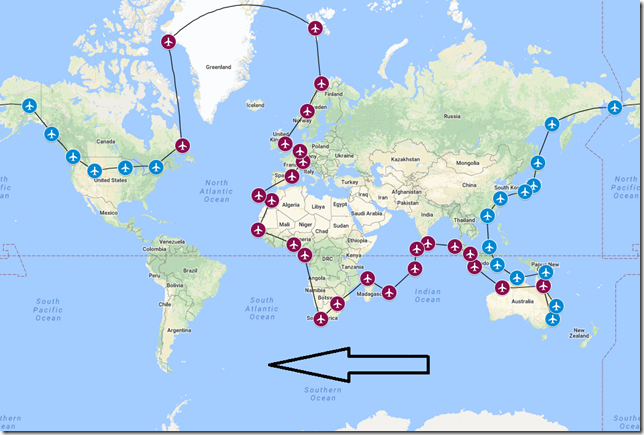
History of City
Ottawa is the capital city of Canada and stands on the south bank of the Ottawa River in the eastern portion of southern Ontario. Founded in 1826 as Bytown and incorporated as Ottawa in 1855, the city has evolved into the political center of Canada with a population of just over 964,000 and a metropolitan population of 1.3 million, Ottawa is the 4th largest city in Canada.
History of Country
Canada is a country located in the northern part of North America. Canada is comprised of ten provinces and three territories which extend from the Atlantic to the Pacific and northward into the Arctic Ocean, covering 3.85 million square miles, making it the world’s second-largest country by total area. Canada’s southern border with the United States is the world’s longest bi-national land border. The capital of Canada is Ottawa.
History of Airport
Ottawa Macdonald-Cartier International Airport is an international airport named after the Canadian statesmen and two of the founding fathers of Canada, Sir John A Macdonald and Sir George-Etienne Cartier. The airport is the 6th busiest airport in Canada. The airport is one of eight Canadian airports that have United States border preclearance facilities.
History of Airline
Air Canada is the flag carrier and largest airline of Canada by both fleet size and passengers carried. Founded in 1937, Air Canada’s corporate headquarters are in Montreal, Quebec with its largest hub at Toronto Pearson Airport. Air Canada’s total fleet size consists of 415 aircraft including all Air Canada subsidiaries (Air Canada Cargo, Air Canada Express, Air Canada Jetz and Air Canada Rouge). Together with its regional partners, the airline operates on average more than 1,602 scheduled flights daily.
Flight Briefing
ACA1066
CYYR – CYOW
Planned Fuel – 19,500 lbs
Planned Altitude – 36,000
Distance – 762nm
Flight Time – 2hr, 30min
Route: YYR L600 YZV V316 PESAC T781 AGLUK T731 TAKOL
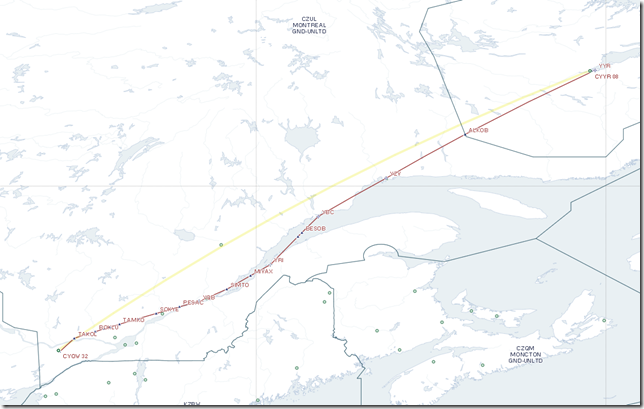
Flight Journal
Our 27th leg has started off much like the 1st, with rain and lots of it. Rain has pretty much been the theme during our stay in the Goose Bay area. But considering the extremely hot and dry conditions our group experienced in the Africa and Europe legs, the cooler and even damp conditions have been a welcome change. The ground crew at Goose Bay have been extremely helpful and we’re assisting Air Canada in moving one of their newly painted Airbus A320’s down to Ottawa.
Loading on our required fuel for this leg of the journey.
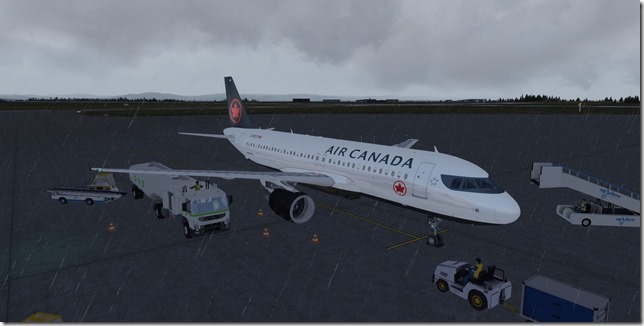
Our passengers have arrived and will soon be boarding. Their bags are enroute to the aircraft as well.

The bags have arrived and are being carefully (yea right) onto the aircraft.

Fuel – check, Baggage – check, Passengers and Crew – check. Time to pushback and get on our way.
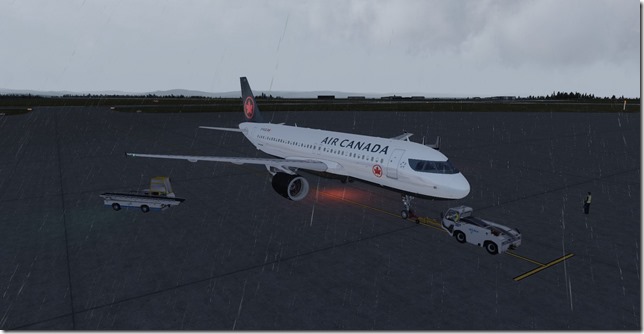
We’ve had lots of cloudy departures, but not very many wet/rainy ones. Taxing out to the active runway.
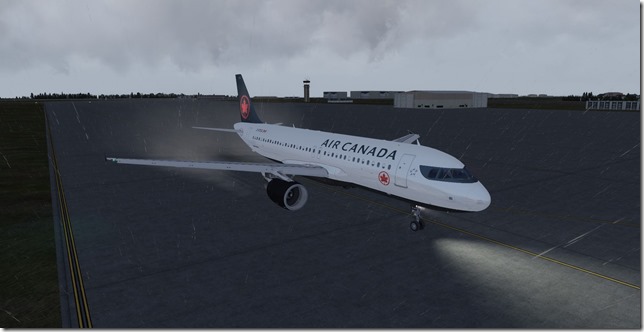
Cleared for take-off.
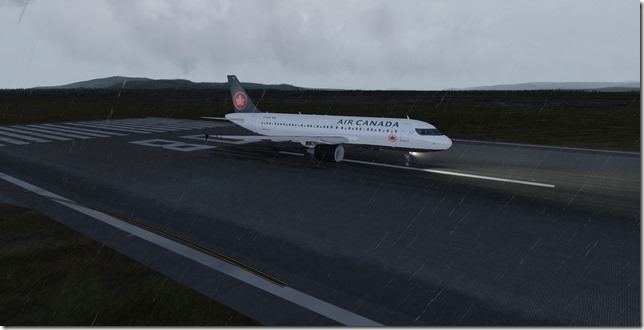
Blasting out of Goose Bay and on our way to Ottawa.
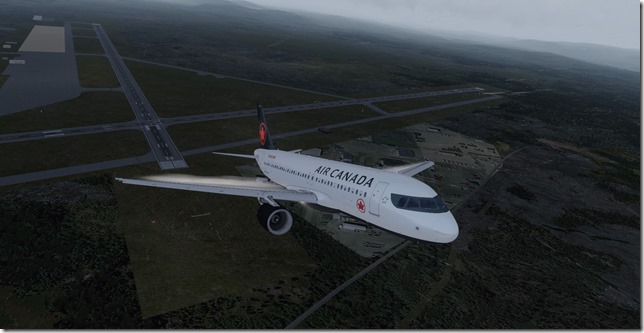
Making our turn to the right to join the SID or Standard Instrument Departure course out of Goose Bay.
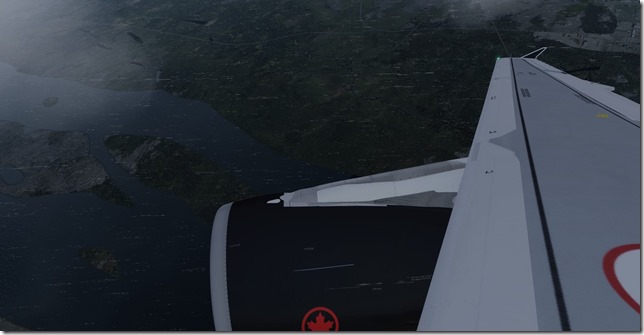
The rain continues to fall as we’re climbing out. We’ll soon be above the clouds and clear of this weather.
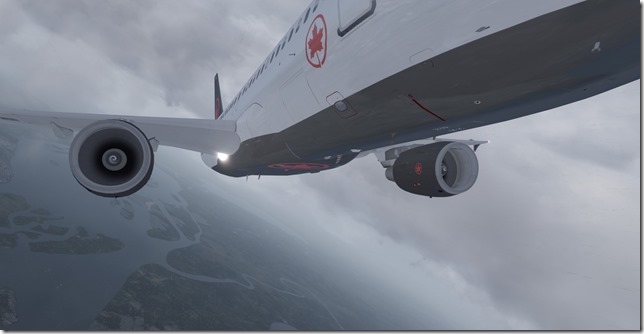
Finding ourselves in another cloud sandwich.
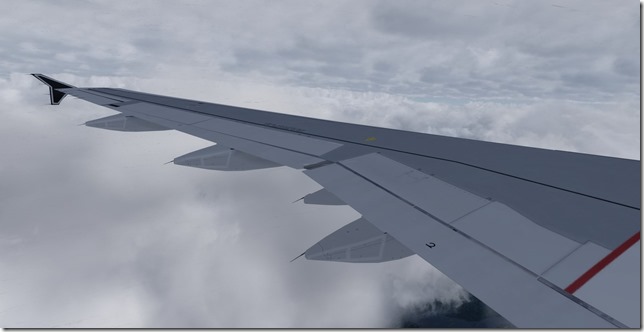
The view from the flight deck. Keeping an eye on the weather radar. ATC vectored us around the strongest of the cells and we should be in clear skies shortly.
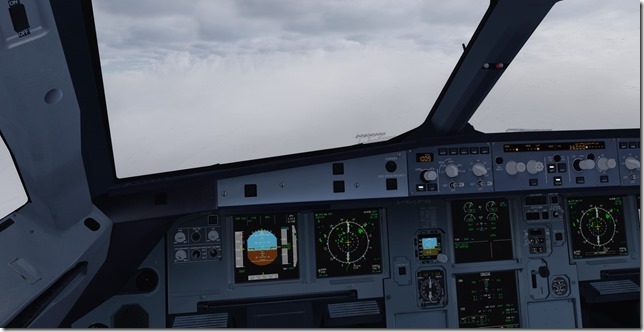
There we go. Clear skies all around.
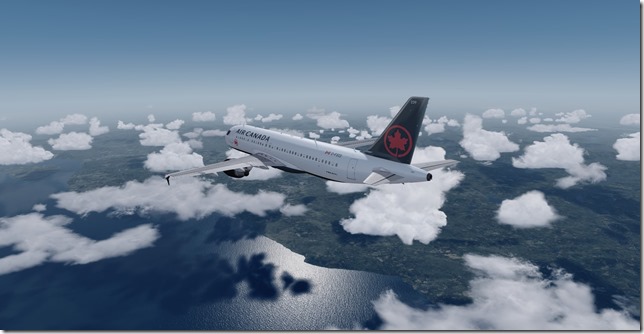
Cruising at flight level 360 as we zoom across Quebec.
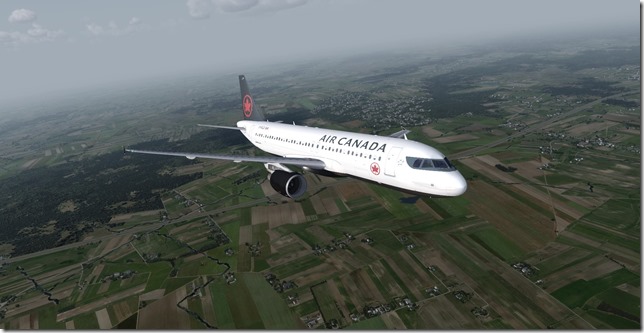
Nice lush landscape as we begin our descent into the Ottawa area.
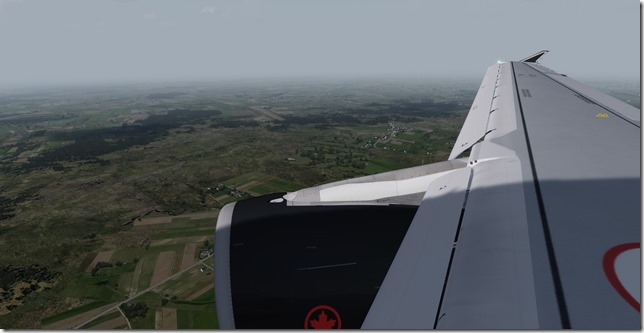
On final approach into the Ottawa Macdonald-Cartier International Airport.

Runway in view.
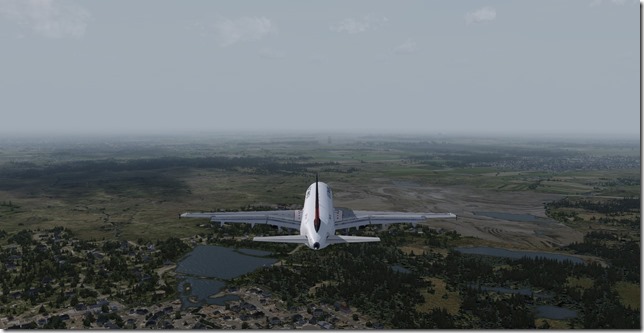
Cleared to land.
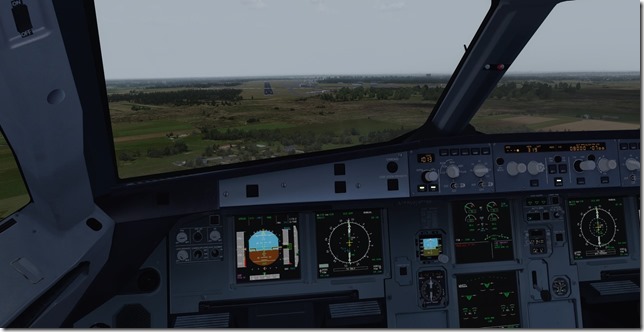
Our passengers are able to deboard via the airport jetbridge and will also be able to clear US customs here in the Ottawa airport.
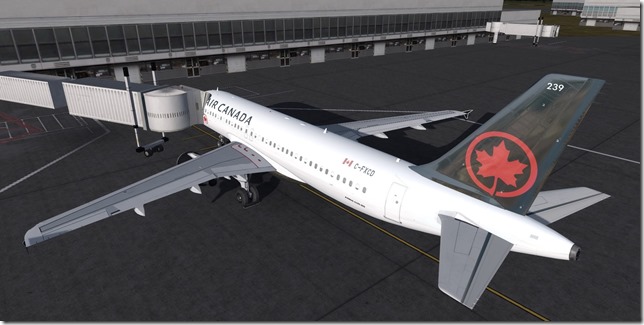
Simulator Specifics
Prepar3d v4.3
ActiveSky Weather Engine
ActiveSky Cloud Art
Envtex & Envshade
FSLabs Airbus A320 (Air Canada livery)
Orbx Global Texture
Orbx FTX Global openLC North America
VATSIM
Route Planning Tools
AivlaSoft, PFPX & Simbrief
Navigraph Charts Desktop
FlightAware
FlightRadar24
SkyVector
Google Maps
Computer Hardware Specs
My plan is to fly two more legs of the tour before I leave for vacation which should place us in Jackson Hole, Wyoming. This will mean that while I arrive back home on the 7th of September, I will have a two week buffer. I most likely will get started flying the tour segments once again within a few days of arriving back home, but in the event I’m just too busy then I’ll have the flexibility. As mentioned at the top of this article, I do plan to double up a few postings either in late September or early October so that we can complete the tour around time of the official tour wrapping up.
Thanks for reading this tour update. Have a great day!
Until next time….
Happy Flying!!!
JT
September 10, 2018 / admin / 0 Comments
Tomorrow marks the 17th anniversary of the 9/11 attacks. Tomorrow I’ll begin my day just like I did on 11 September 2001 and each year since. I’ll wake up early, take my shower, get dressed and head downstairs for my morning coffee and to watch the morning news. I’ll spend a few minutes thinking about my grandfather as this year would have marked his 98th birthday, then between the thoughts of my grandfather and the images of the 9/11 memorials, reading of the names and the moments of silence, this 52 year old man will ball his eyes out for much of the rest of the morning.
On the morning of Tuesday, 11 September 2001…it was like any other morning for me. My weekday morning ritual hasn’t changed much since college. For much of my adult life I have been an early riser. At this particular time in my life I was living alone. My now wife (who I had met a few months prior) was still living in England and I was scheduled to leave Denver to fly to London on Friday, 14 September. I had just sat down on my sofa with coffee in hand about 6:30 AM MT. I remember (just like it was yesterday) the morning news anchors (Fox News) talking about what a beautiful fall-like day it was in New York City. As I only lived about 5 minutes from my office, I would often leave my apartment about 6:45 AM to allow myself plenty of time to be in the office just before 7. But this morning…and I can’t explain why, I felt the need to stay on the sofa a bit longer and finish that first cup of coffee.
The first plane hit the World Trade Center at 6:46 AM MT. Within what just felt like seconds, Fox News was showing the smoke pouring from the north tower. The news folks kept talking about what a beautiful day it was in NYC and initial speculation was somehow a sightseeing aircraft must have accidently crashed into the WTC. Being interested in aviation, I decided to continue watching the news that morning for just a few minutes longer. With my coffee cup in one hand, and the TV remote in the other…I was just about to click the off button when the second plane crashed into the south tower. It was obviously clear the first plane was no accident and something terrible was playing out before our very eyes.
At the time, I was working for a small tech company and part of my day to day role dealt with crisis management, business continuity and disaster recovery. Without knowing everything that was occurring in New York City, I decided I had better get to the office as we had offices and customers in the NYC area and I would need to begin looking into how these events would impact our operations. By the time I reached the office, the third plane had crashed into the Pentagon and we all watched in shock and horror as both the South and North towers collapsed and we eventually learned of the fourth plane crashing in Pennsylvania.
In the days after the attacks, I would come home, have dinner and watch the news to try to understand what had happened and why. Generally just before bedtime, I would go for a walk around the park next to my apartment. The extremely noticeable lack of aircraft was deafening.
What does all this have to do with flight sim?
Just a few months prior to the 9/11 attacks, the VATSIM network began operations and I had just started flying (virtually of course) for an American Airlines virtual airline. Just a few days before 9/11 I had assumed the role of VP of Operations of the VA. After the attacks of 9/11 and during the period of time the FAA had grounded all civilian air traffic, VATSIM also shut down their servers out of respect. As I felt then, and still do to this day…the actions taken by VATSIM were correct and extremely commendable.
What I’m going to say next is going to be very unlike me. I don’t typically mix politics and/or real world issues into my writings. But in the days after 9/11, everywhere you looked American flags were proudly flying. We were all Americans…we were all proud to be Americans and we stood behind our President as proud Americans. Today, 17 years later…we barely resemble the same country. We’re as divided as we’ve ever been in my lifetime and there’s so much hate towards not only our President, but also for law enforcement. No longer can people simply just disagree. Disagreement often leads to various accusations including racism, sexism etc.
I pray daily for peace, I pray daily that the events we witnessed on this day 17 years ago won’t happen again and I pray daily for our country. I pray that we as once proud Americans can once again be at peace with one another and that patriotic spirit which makes this the greatest country on earth can heal our divided wounds.
Thank you for reading.
Jerry
P.S. I’ll return next Monday with my usual non-political style of writing, until then…..may God continue to bless us all and may we all strive for peace and kindness in everything we do.
September 8, 2018 / admin / 0 Comments
As our travelers depart Greenland to begin the North American segment of our 2018 WorldFlight tour, in the real world my wife and I will be spending our last day/evening in Tunbridge Wells, Kent, England. Tomorrow (9 Sept) we will head into London and London Heathrow for our British Airways flight back to Denver. Just as a reminder, I’m writing these updates before even leaving on vacation. At the time I’m writing this update, it’s about two and a half weeks before we leave. Upon returning, I’ll be sure to fill you all in on the vacation trip. My plan is to continue flying these tour legs and writing up the blog postings until we leave, so hopefully by the time we actually leave the US for Belgium, I’ll have completed most of the North American flights, this way I have a bit of a buffer where I can ease back into my work life (which will be busy), but continue to keep these flight updates coming to you on a regular basis.
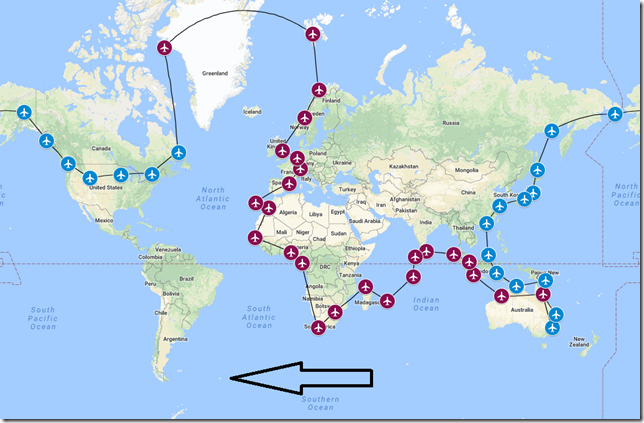
History of City
Located in the central part of Labrador on the coast of Lake Melville and the Grand River, Happy Valley-Goose Bay is the largest population center in this region of Canada.
History of Country
Canada is a country located in the northern part of North America. Canada is comprised of ten provinces and three territories which extend from the Atlantic to the Pacific and northward into the Arctic Ocean, covering 3.85 million square miles, making it the world’s second-largest country by total area. Canada’s southern border with the United States is the world’s longest bi-national land border. The capital of Canada is Ottawa.
History of Airport
Goose Bay, is a Canadian Forces Base operated by the Royal Canadian Air Force, but also has shared use operations with several civilian airlines.
History of Airline
Air Transat is a Canadian low-cost leisure airline based in Montreal, Quebec operating both scheduled and charter flights serving 63 destinations in 30 countries.
Flight Briefing
TSC1066
BGTL – CYYR
Planned Fuel – 24,000 lbs
Planned Altitude – 38,000
Distance – 1405nm
Flight Time – 3hr, 30min
Route: THT NADMA NALDI MUSLO DUVBI YYR

Flight Journal
Our travelers began their world tour way back on 6 June when we departed Sydney, Australia and with another two months ago they are just a little over the half-way mark of their trip. This leg will start the North American tour segment and will have them visiting three different airports in Canada, two airports in the lower 48 of the United States and two different airports in Alaska before heading to Russia, Japan and China as we make our way back down under to our starting point of Sydney. We’ve shifted our schedule slightly and will have another tour break once reaching Jackson Hole, Wyoming and another shorter break in Sitka, Alaska.
We’re all present and accounted for, so let’s get started. Our journey today is just over 1,400 miles and we should land in Goose Bay just before the sun sets.
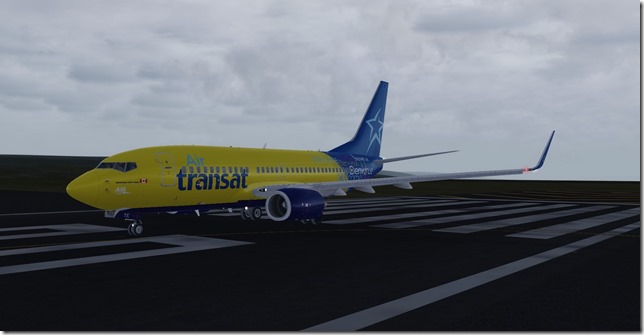
Goodbye Greenland! You were a wonderful host.
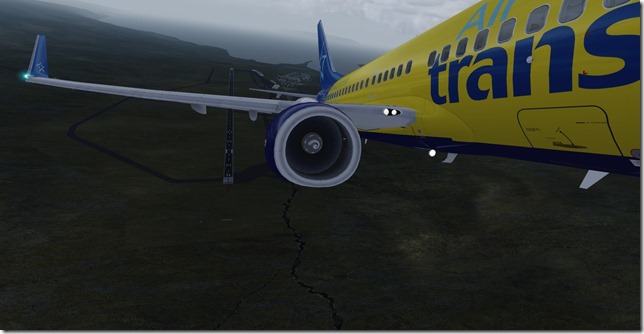
A cloudy departure out of Greenland.

A little bit bumpy as we climb out.
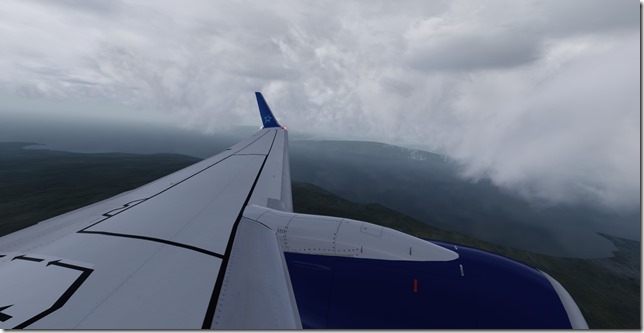
A much smoother ride at our cruising altitude of 38,000 feet. Our Air Transat B737-700 is one of the more colorful liveries we’ve had thus far.
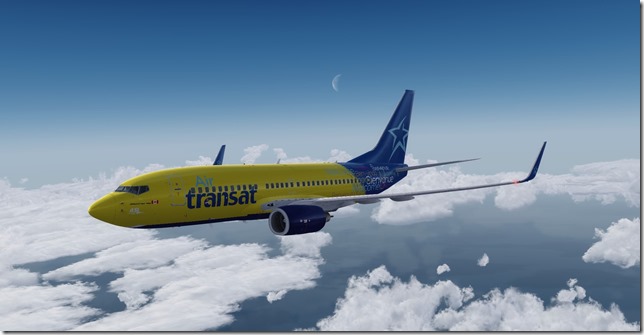
Almost to our destination. The Grand River just off our right wing. We’ll see that again shortly.
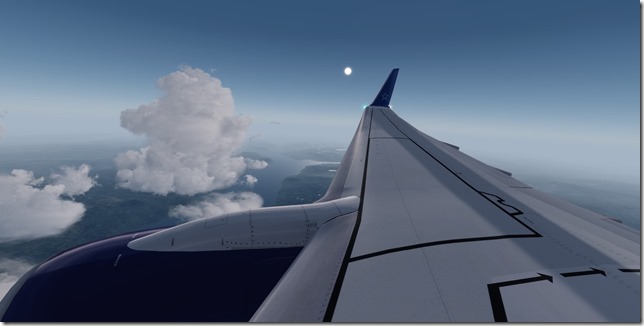
Making our turn to final.
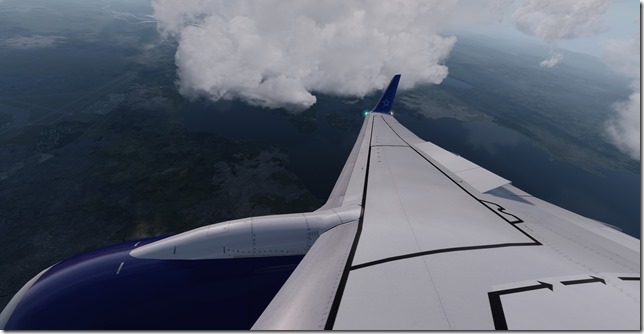
Once again, the Grand River as we’re on final approach into Goose Bay.
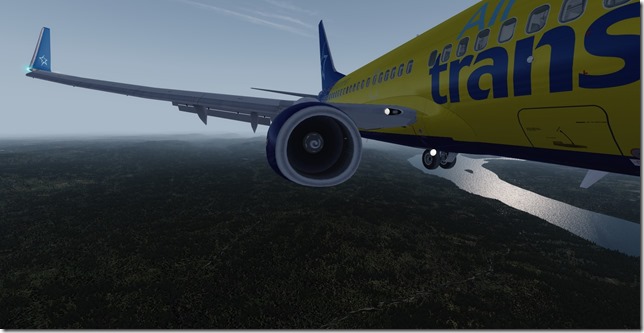
That’s a gorgeous river.
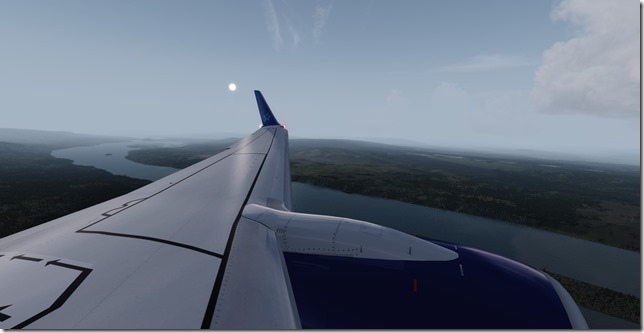
Clear to land as we fly over the Grand River once again.
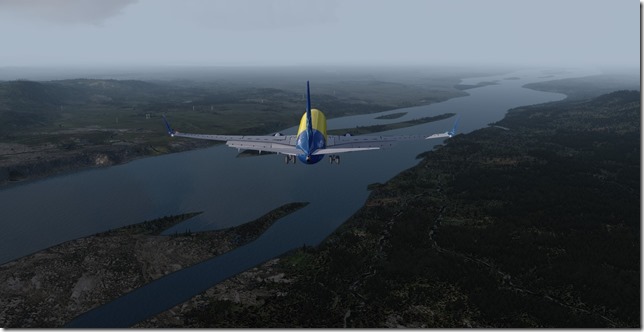
Parked up and awaiting the bus who will take our travelers to customs and then on to the hotel.
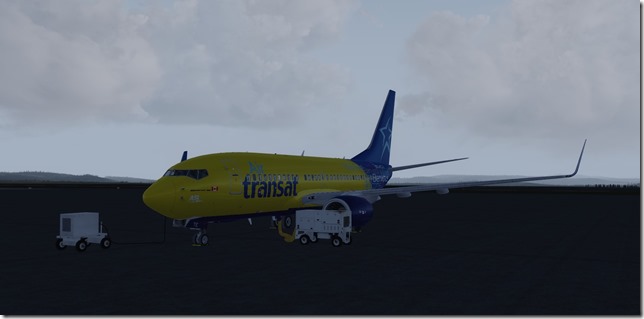
Simulator Specifics
Prepar3d v4.3
ActiveSky Weather Engine
ActiveSky Cloud Art
Envtex & Envshade
PMDG Boeing 737-700 (Air Transat livery)
Orbx Global Texture
Orbx FTX Global openLC North America
VATSIM
Route Planning Tools
AivlaSoft & PFPX
Navigraph Charts Desktop
FlightAware
FlightRadar24
SkyVector
Google Maps
Computer Hardware Specs
Another long, but exciting flight is in the logbook. Our stay in Goose Bay will be brief. Soon we’ll depart for Ottawa. I hope you’ll join us as we continue our 2018 WorldFlight Tour.
Until next time…
Happy Flying!
Jerry
September 5, 2018 / admin / 0 Comments
As we begin this leg of the journey, we find ourselves on top of the world. As mentioned in the last update, our final departure location in Norway is the highest point in the northern hemisphere we’ll visit. We were going to take another week-long pause, but our travelers wanted to to delay that until we reached North America. The group took a vote and all agreed to take that week long pause once we reach Jackson Hole, Wyoming. This will allow them more time to spend in the mountains. So the plan is to add a few extra days to the stay in Jackson Hole and a few extra days once we reach Vancouver.
Unfortunately, as you are reading this posting….our European vacation is almost coming to a close. We’ll be flying back to Denver on the 7th and will have two days to re-acclimate back to the USA time zone before returning to work on Monday, 10 September. I’ll make sure to tell you all about my vacation, the flights and all the wonderful food I’m sure we’ve enjoyed the past two weeks. But for now, let’s get started with the tour update.
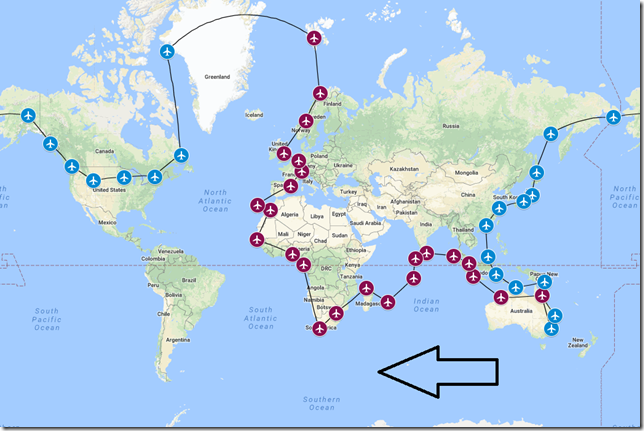
History of City
While not technically a city, Thule Air Base is a United States Air Force base located 750 miles north of the Arctic Circle and 947 miles from the North Pole on the Northwest side of Greenland. Thule Air Base is the US Armed Forces’ northernmost base. This is the only place on earth where four active glaciers join together.
History of Country
Greenland is an autonomous constituent country within the kingdom of Denmark located between the Arctic and Atlantic Oceans. Greenland is the world’s largest island. While Australia and Antarctica are larger, they are generally considered to be continental landmasses rather than islands. Greenland has been inhabited off and on for at least the last 4,500 years by arctic peoples whose forebears migrated there from what is now Canada.
History of Airport
See history of city.
History of Airline
Icelandair is the flag carrier of Iceland and headquarted at Keflavik International Airport. As of April 2018, Icelandair operated scheduled services to 48 cities in 16 different countries on both sides of the Atlantic Ocean.
Flight Briefing
ICE1066
ENSB – BGTL
Planned Fuel – 19,000 lbs
Planned Altitude – 38,000
Distance – 1018nm
Flight Time – 2hr, 52min
Route: GOLO1B GOLOL 79N010E 80N000E 81N010W 81N020W 81N030W 81N040W QQ W20 THT
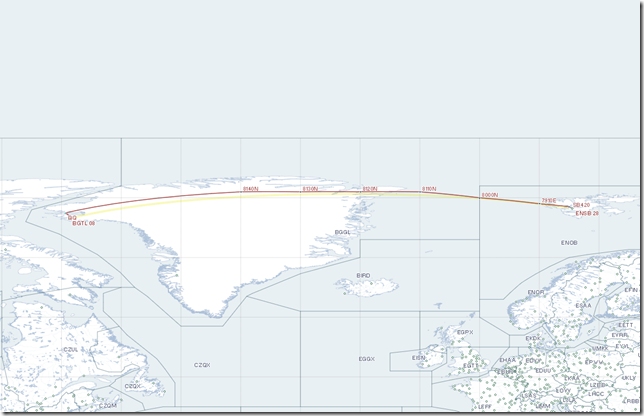
Flight Journal
Over the course of the past several months, our travelers have been exploring two dozen different cities in 19 different countries within Eurasia. This leg will transition us over to the North American segment of our tour where after departing Greenland, will visit three cities in Canada and four cities in the United States before heading back over toward the Eurasia side of the world. Up to this point of our tour, we’ve traveled just under 20,000 miles, spent approx. 57 hours flying and have burned more than 350,000 pounds of jet fuel.
Our flight today is just over 1,000 miles and we’ll be flying an Icelandair Boeing 737-800. Our travelers have arrived and are both ready and anxious to board and continue their jouney.
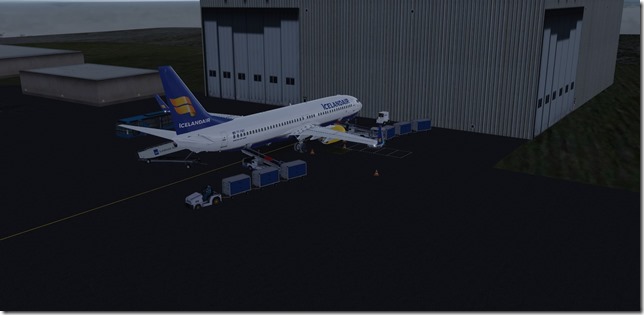
Push back and engine startup procedures underway.
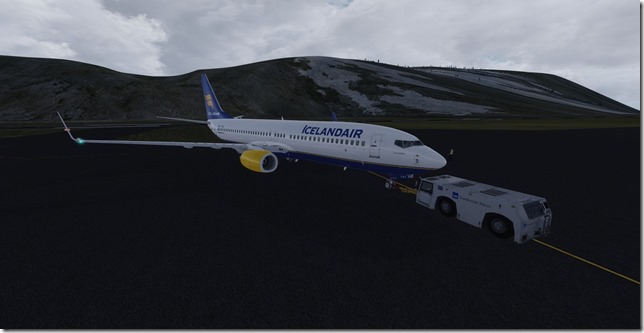
The great thing about these smaller airports is the short taxi ride out to the active runway. From completion of pushback, we can often be lined up and ready to go in 5-10 minutes. Some larger international airports the taxi ride can be 20+ minutes if not longer.

Positive rate, Gear up
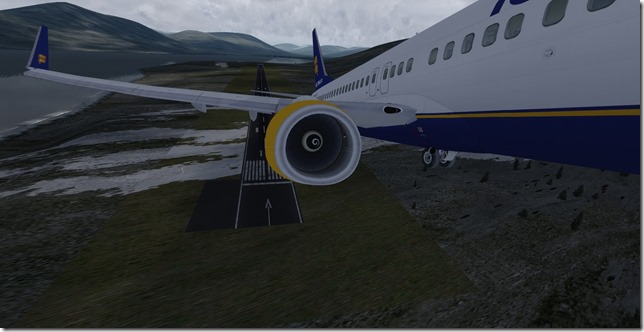
Goodbye Norway, you’ve been a most excellent host.
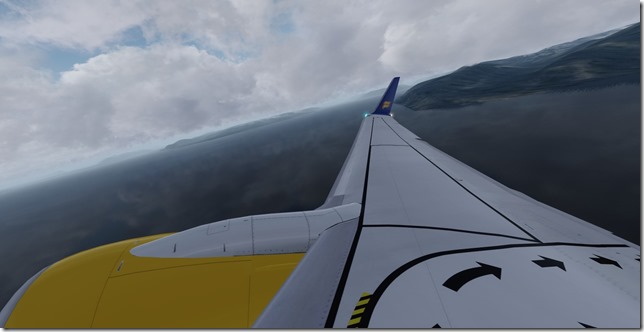
Climbing out on the departure route.

Climbing up to our cruising altitude of 38,000 feet.
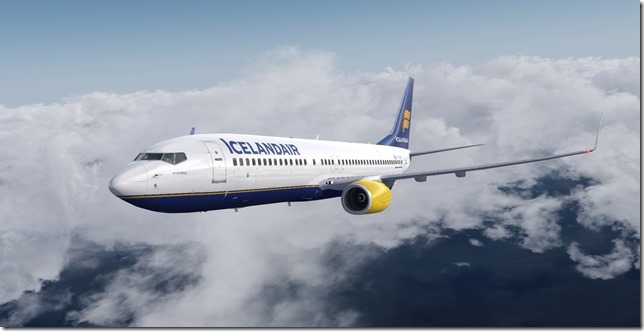
The eastern coast of Greenland just off the left side.
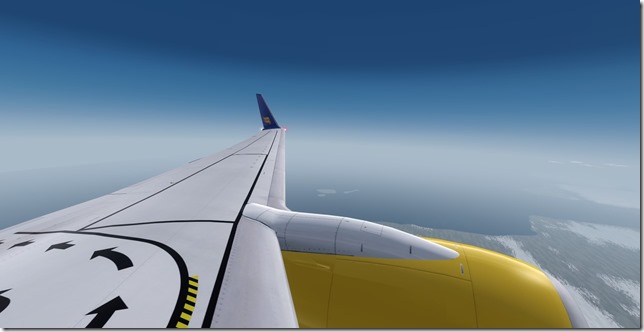
I’m sure there’s some green below.

Can’t forget to showcase our Icelandair Livery.

Below the clouds.

Greenland is really green.

On long final with the runway just appearing in the distance.
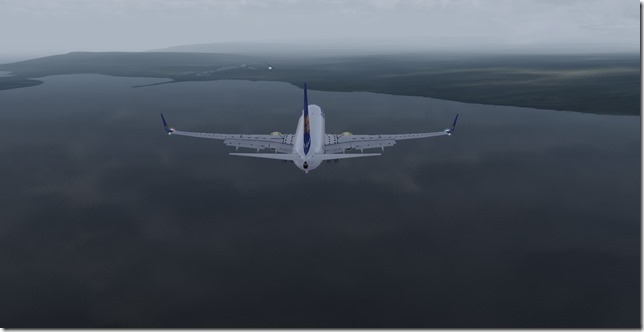
C is for crosswind and we have a strong one.
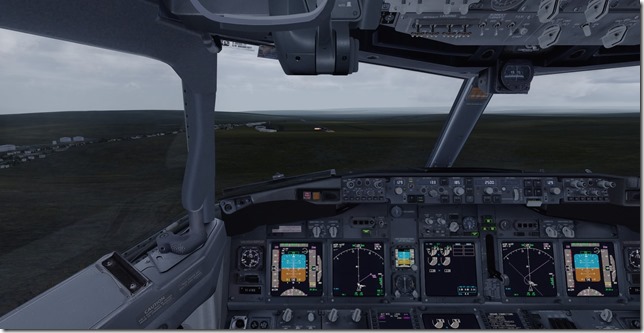
Simulator Specifics
Prepar3d v4.3
ActiveSky Weather Engine
ActiveSky Cloud Art
Envtex & Envshade
PMDG Boeing 737-800 (Icelandair livery)
Orbx Global Texture
VATSIM
Route Planning Tools
AivlaSoft & PFPX
Navigraph Charts Desktop
FlightAware
FlightRadar24
SkyVector
Google Maps
Computer Hardware Specs
Another fantastic flight is officially in the logbooks. Our next flight is another long one at 1,400 miles. We’ll be flying the Boeing 737 once again as we fly from Greenland down to Goose Bay, Canada. I think it’s time for me to say those three words….
Until next time…
Happy Flying!
Jerry
September 3, 2018 / admin / 0 Comments
This will serve as the introduction and first of a multi-part blog tutorial series for how I learn and fly sim aircraft that might be classified as the more complex, study-level, payware aircraft types. While some will argue that products developed by QualityWings, CaptainSim, Carenado, Aerosoft (just to name off a few) aren’t in the same category or classification as the likes of PMDG, A2A or FSLabs. While I agree partially with this argument, there is still a learning process with these different aircraft models and more or less the same method I use can be applied to each of them.
The Fine Print
I’m sharing the methods I use to learn and fly study level aircraft. This series of tutorials are not designed to be the end-all, be-all of methods to accomplish this task. These are simply the methods which have worked well for me over the years. Actually, the process has become a lot easier since the dawn of YouTube and Google. If you have different methods that work, great. Likewise, if you prefer to first start by studying the Boeing manual…I take my hat off to you. However, many of us just don’t have the time, nor the desire to go to the full depths of understanding when it comes to “when I flip this switch in the cockpit, this is what is happening behind the scenes with all the complex theory behind it” type scenario. As I have stated many times…I have no desire to learn how to fly a plane in real life. But I get a lot of stress relieving satisfaction from the time I spend in flight sim and the other simulation based platforms I enjoy. There’s nothing wrong with any method. Let’s get on with this first tutorial.
The New Aircraft
So PMDG, FSLabs, QualityWings etc. have released their latest and greatest version of whatever real world airplane they’ve been spending years developing. This new virtual aircraft is the closest thing us flight simmers can experience to the real thing short of spending time in a full-size simulator or becoming a real-world airline pilot. Almost every button, switch, dial in the cockpit has been programmed to simulate the same real-world operation we’d find on the real flight deck. It’s truly a thing of beauty…but, just like in the real world…a series of steps must be carried out and in most cases these steps must be followed in a specific order before we’ll ever get the aircraft into the skies.
I don’t know about you, but when I first purchase, download and install the latest and greatest from my favorite developers the first thing I really want to do is fly the darn airplane. While I absolutely love flying on the VATSIM network, I’ll never fly a brand new aircraft until such time as I’ve learned more about the aircraft and can perform all the necessary functions as not to embarrass myself on the network or more importantly, not cause any disruption or dissatisfaction with other pilots.
I’ll be open and honest, in the beginning for each new aircraft I’m just concerned with the minimum effort needed to get the aircraft in a state where I can fly it, control it and land it. Once I can do this….I then proceed with diving a little deeper and deeper into the aircraft. As time goes by, I’m following more of the “checklist flows” for how things are done. Once I reach this point, this is when I’m willing to use the new aircraft on the VATSIM network.
Over the course of the next few written tutorials, I’ll share the steps I follow to learn these new aircraft and to develop a proficiency at flying them well enough to fly online. As I’ve stated in the past, I’ve been flying on VATSIM from the very beginning. I have over 18 years of online experience, I’ve never been banned, I’ve never been given a warning. I take great pride in always being professional and always following the rules.
But how do I begin the learning process?
Read the Manual
Yes…it starts with reading the manual. I’m sure you’re probably thinking to yourself, surely (don’t call me Shirley) Jerry has figured out a better process to all this versus reading the manual. Well…all I can say is the manual generally has a lot of valuable information that will assist you in the process of learning your new aircraft. But even I’ll admit that a lot of the information contained in these manuals provide more of the theory behind how things function versus the how do I do this and why should I do this procedure. But at the very least….know where the manual is located (where it’s been installed on your PC) and familiarize yourself with it. It’ll make for great reading material during the cruise phase of your first flight.
Tutorial Flight
Most complex, payware aircraft will include a tutorial flight. As I begin laying out the framework of this article (early July timeframe), I’m in the process of learning the FS Labs Airbus A320 (and the A319). I’m relatively new to the FSLabs Airbus and you can read more about my decision to purchase this add-on here. The tutorial flight for the A320 is a short flight from Vienna, Austria to Copenhagen, Denmark. It’s written in a step-by-step fashion and can very easily be followed.
For as long as I can remember, I’ve always learned by doing. I can sit in a classroom listening to someone explain something until my eyes glaze over and not learn a thing. Or I can actually roll up my sleeves and follow along by actually doing the same thing the person is talking about and learn everything I need to know. Well, learning how to fly is the same thing for me. The FS Labs tutorial flight is one of the best documented processes I’ve seen and after flying this flight twice, I was ready to fly to other destinations using the processes documented in the tutorial.
YouTube is your Friend
The first complex payware aircraft I purchased was the Level-D 767. This aircraft came out before YouTube was born and I must admit that the learning curve for the 767 (for me) was much steeper than any other aircraft since the dawn of YouTube. Prior to the 767, I was a CTRL-E kind of guy. So trying to follow along in the manual (and I can’t remember if there was a tutorial) was much like trying to fly to the moon. But now days, within days (sometimes hours) of an aircraft release, you’ll find really detailed videos from very talented individuals on full, immersive flights.
Some YouTube content creators will go over the flow based on the provided checklists and others will hit the highlights of just what’s needed to power up the aircraft and fly it. As I previously mentioned, I’m more inclined to initially take the path of least resistance in the beginning. But there are a few real world airline pilots who also record YouTube videos and stream on Twitch while flying in P3D. I thoroughly enjoy watching their content, especially once I’ve somewhat mastered the basics and it helps me to then go back and fill in some of the areas I’ve either missed or perhaps just don’t understand why a process is done.
Checklist Flows
Once you’ve completed the tutorial flight(s) and have a better understanding of your new aircraft. Future flights are easier and setup a lot faster when using a checklist. Again, most of the developers will include a checklist within the documentation of the aircraft. However, in some cases these checklists when used without any additional aids may not be enough to get you over the learning curve. This is where my modified checklists come into play.
Modified Checklists
Generally after a few tutorial flights, then a few flights loosely based on the tutorial flight, I begin creating my own checklist flow. I do this for a few reasons. One, in some instances there are steps on the official checklist that just don’t provide enough details as to the steps I need to follow. For example, in the FSLabs A320 checklist provided in the documents, the first checklist item in the Before Start section is “Cockpit Preparation”. What does all this entail I ask? To a veteran airline captain or first officer, they know all the finer details behind all that goes into this important checklist item. But for me…it’s simply not enough…at least not in the beginning stages. So I’ve developed a method of creating my own Word document lists which somewhat mirror the actual A320 checklist, but at the same time helps me to remember everything I need to do to ensure the cockpit is fully prepped. In addition, when I lay out these flows, I try (as best as possible) to follow a flow that works best for me. Yes, I realize this may deviate from how things are done in the real world. But if it keeps me from having to bounce all around cockpit then that just saves me a little time. And honestly, we’re not talking about major differences…just a few shortcuts here and there. I may consider making an effort to clean these documents up and make them available to anyone interested.
Just to repeat myself
There’s no right or wrong way with these things. Yes, there are those “hard core” types that actually dress up like a real pilot to enjoy their computer based sim. But the thing everyone needs to keep in mind is that what we’re simulating…the workload and role of an airline pilot in the real world is carried out by two highly skilled pilots. Unless you are using an aircraft capable of shared cockpit functionality, you’re really doing all the work typically shared between two pilots. There are add-ons available for some payware aircraft which simulate a multi-crew experience. FS2Crew is one that I’m most familiar with. The add-on is capable of performing various tasks on the flight deck using voice recognition. I’ve used it in the past on the Level-D 767 and one or two of the PMDG aircraft I own. While I’m no longer using it, I certainly recommend it if you’
Final Thoughts
The old saying, “Practice Makes Perfect” is certainly a very wise suggestion. The more you fly your brand new aircraft, the easier it will be to commit all the steps necessary to memory. But remember, even real world pilots use a checklist for each and every flight so don’t feel bad if you (from time to time) need to reflect back to your checklist. It’s just all part of the process. Finally, for the sake of all others (and your own reputation)….spend a little (or a lot) of time flying your new aircraft off-line to familiarize yourself with it fully before contemplating going online with VATSIM, IVAO or the other online networks.
I hope this information helps you.
Until next time…
Happy Learning!
Jerry
September 1, 2018 / admin / 0 Comments
Before we get started with this tour update, I would like to remind everyone why I’m doing this. When you have a moment, (or right now) please visit the WorldFlight website. This is the official site for the 2018 event and from that webpage you can find links to other sites such as Simfest UK, CB-Worldflight Team USA and others. Each team of participant groups from around the world are raising money for various charities. The official WorldFlight Event for 2018 will begin on 3 November at 2200z with teams departing Sydney, Australia and conclude a week later on 10 November around 0845z back in Sydney. These teams will stream their flights on Twitch and YouTube for the world to watch and hopefully donate towards the charities these teams are sponsoring.
This particular tour update has many special meanings for us and our long journey around the world. First, it somewhat marks the downhill segment of our tour. However, we’re still flying somewhat uphill on the globe. Second, today is the 1st of September and for those of us in the northern hemisphere it means fall is just around the corner and third…it marks the start of the 3rd month of our long tour. Finally, upon landing we’ll reach the furthest in latitude we’ll achieve on this tour. With our starting location of Sydney, Australia being the furthest south.
Now in the real-world, my wife and I should be enjoying the English Countryside down in Kent (Tunbridge Wells). We would have departed Antwerp yesterday for the short 1 hour hop over the North Sea, then traveled by train from London City Airport out to the southeast of England. Pretty much our favorite place on earth. Of course I’m writing and posting this in advance of leaving for our vacation.
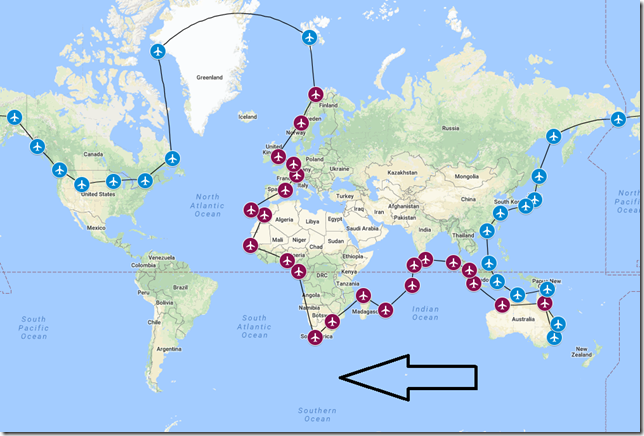
History of City
Svalbard is a Norwegian archipelago in the Arctic Ocean. Situated north of mainland Europe, it is about midway between continental Norway and the North Pole. The islands were first used as a whaling base in the 17th and 18th centuries. Coal mining came to the area in the early 20th century with the establishment of several permanent communities. Svalbard is a breeding ground for many seabirds, and also features polar bears, reindeer and the arctic fox just to name a few.
History of Country
Norway is a unitary sovereign state in Northwestern Europe whose core territory comprises the western and northernmost portion of the Scandinavian Peninsula. Norway has a total area of 148,747 square miles and a population of 5,258,317.
History of Airport
Svalbard Airport, located in Longyear is the main airport serving Svalbard, Norway. It handles approx. 150,000 passengers annually.
History of Airline
Scandinavian Airlines, usually known as SAS is the flag carrier of Sweden, Norway and Denmark and operates out of its main hub at Copenhagen-Kastrup Airport with connections to over 50 cities in Europe.
Flight Briefing
SAS1066
ENTC – ENSB
Planned Fuel – 12,000 lbs
Planned Altitude – 38,000
Distance – 517nm
Flight Time – 1hr, 40min
Route: TC603 LOMVI P853 UVSAS BJO PITOL ATSOT ISD LALAD LOLVO
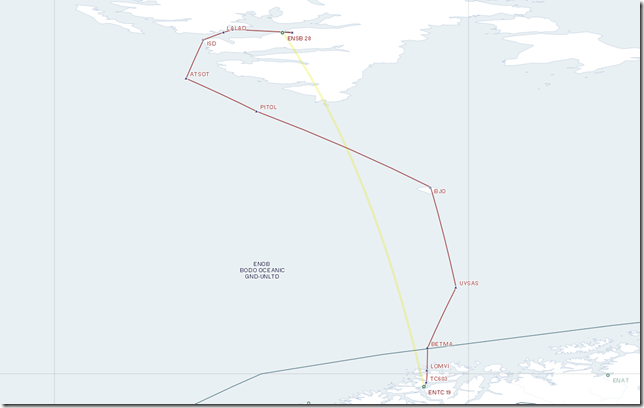
Flight Journal
The theme of today’s (or actually, should I say tonight’s) flight is “Chasing the Midnight Sun”. To somewhat maximize our travelers time while visiting Norway, we’ve been departing during the late evening hours. The flight tonight is no different as we have a scheduled departure time of 11:00 PM. My flight crew and I have arrived at the airport and in the process of getting our Boeing 737-800 ready to go. We’re shuttling another SAS aircraft and this happens to be a real world flight as well which is operated by SAS and also in the B738.
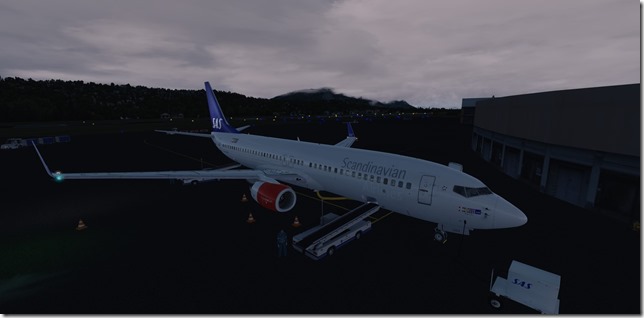
Pushing back with the help of the SAS ground crew. It’s just before 11, we should be airborne in the next 10 minutes.
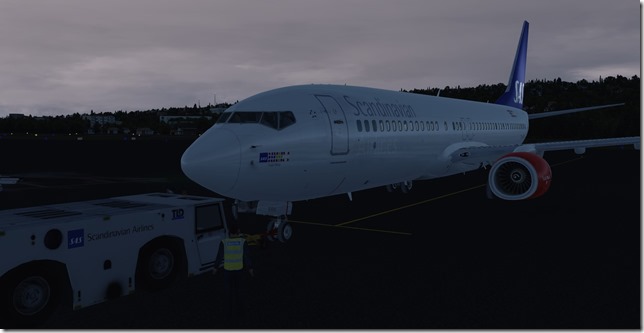
Lined up and ready to go.
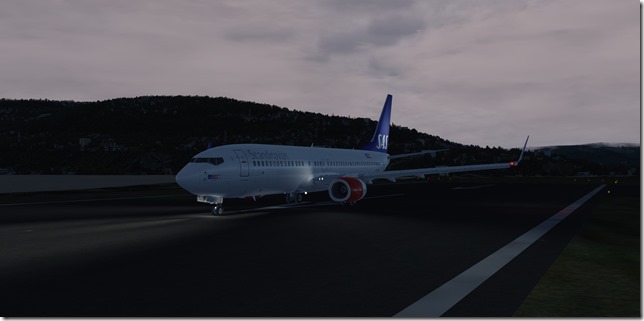
Off we go into the clear cloudy somewhat blue yonder.
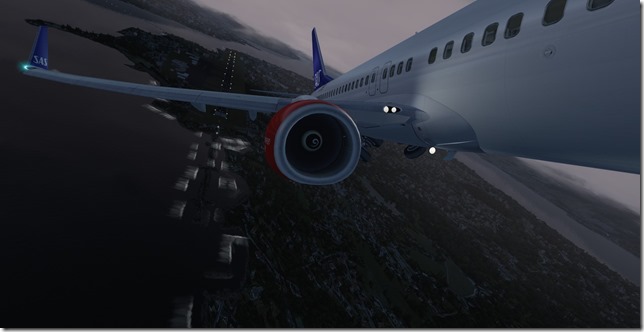
Making our right-turn to join the departure route.
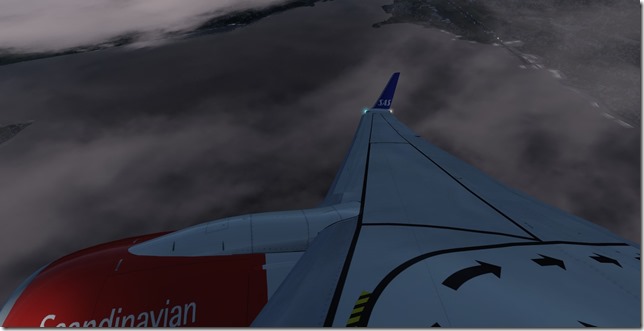
We’ve passed through one layer of clouds only to find another.
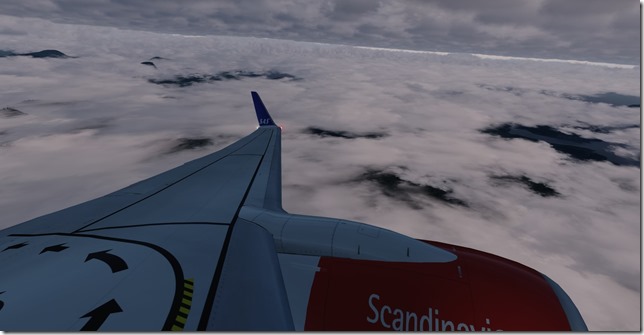
I’m sure we’ll find some clear skies soon.
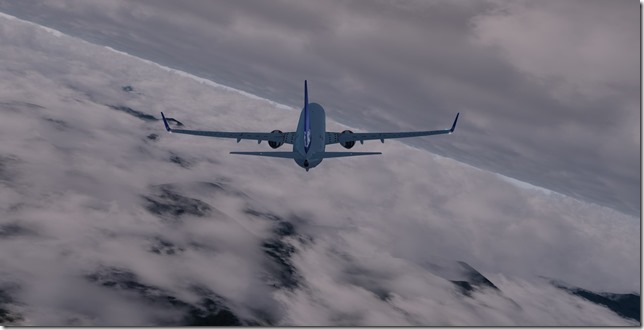
Finally we’ve climbed above the clouds and are on our way of chasing the midnight sun. This time of year the sun at this latitude never sets fully. During our flight the sun will begin to rise again before we land.
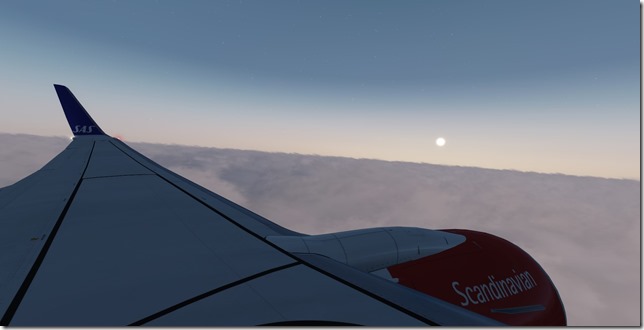
Just before top of descent, our B738 is bathed in the light of the rising sun.
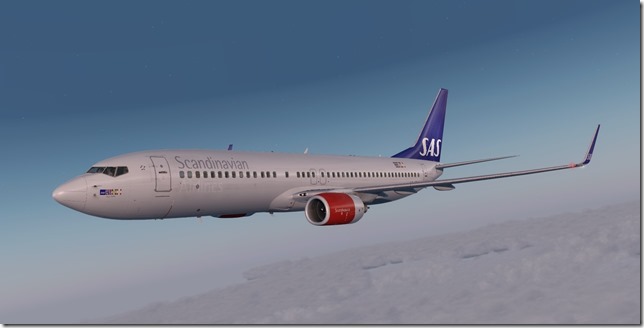
It’s midnight.
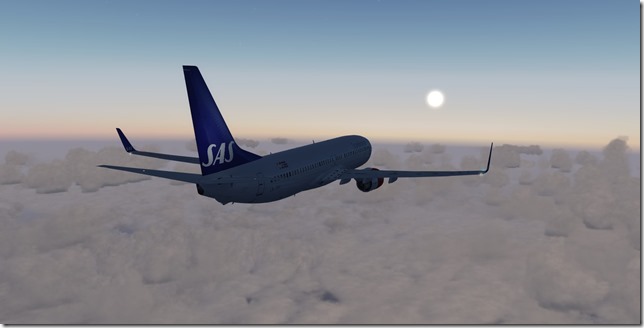
The moon is visible off the right wing.
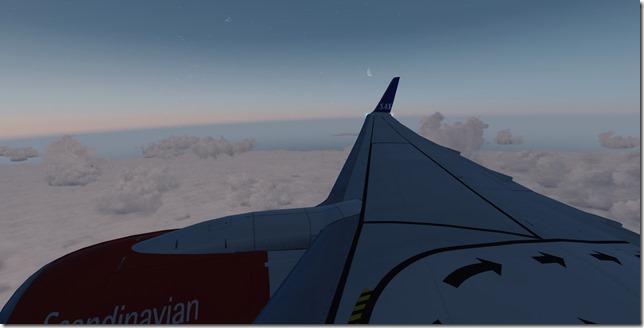
The arrival into Svalbard is quite challenging and made even more so under this level of visibility. But in our instruments, we trust.
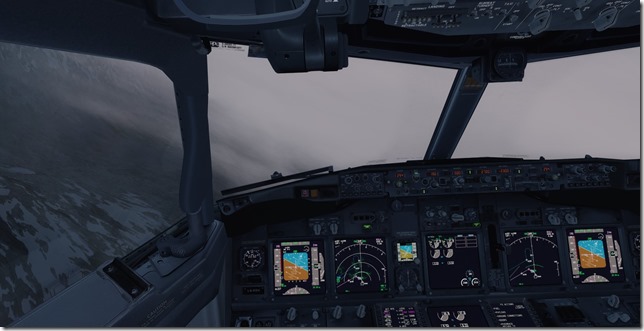
On final, the PAPI lights are visible.
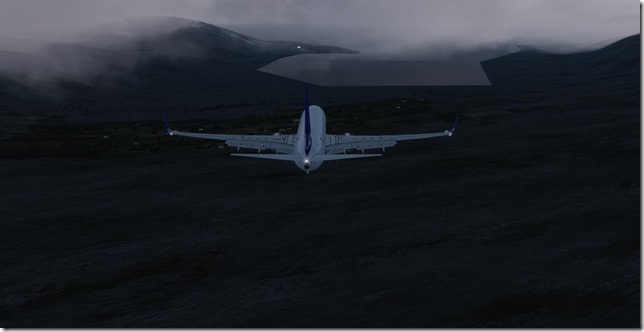
Such a nice approach.
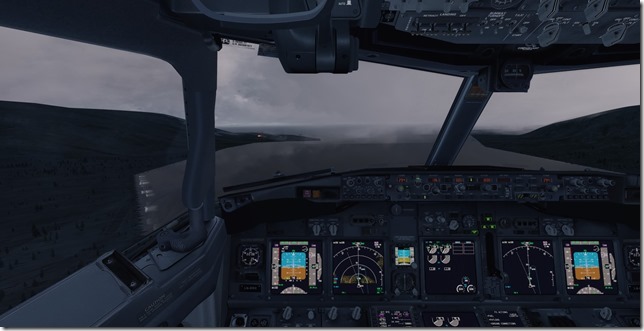
Cleared to land, runway 28. I’ll most certainly want to try this approach under clear conditions as I’m sure the views are simply amazing.
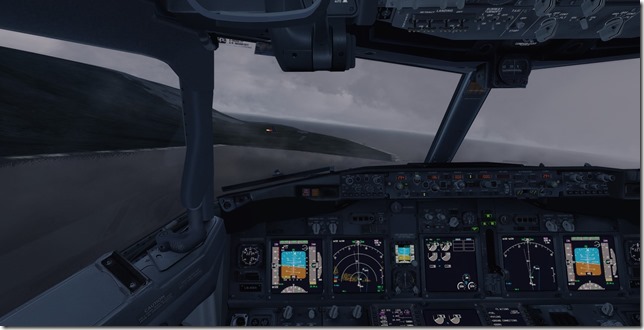
Parked at our gate and ready to deboard our passengers.

Simulator Specifics
Prepar3d v4.3
ActiveSky Weather Engine
ActiveSky Cloud Art
Envtex & Envshade
PMDG Boeing 737-800 (Scandinavian livery)
Orbx Global Texture
VATSIM
Route Planning Tools
AivlaSoft & PFPX
Navigraph Charts Desktop
FlightAware
FlightRadar24
SkyVector
Google Maps
Computer Hardware Specs
While it’s late, our travelers will spend the next two days exploring this area of Norway and do so mostly in the late afternoon and evenings. Tomorrow evening they’ll take a special tour (weather permitting) to once again enjoy the midnight sun and dinner in a beautiful Norway. As previously mentioned, this is as far North we’ll travel on our tour. Once we depart Norway, we’ll fly west to Greenland and being our North American tour segment. I hope you’ll join us.
Until next time…
Happy Flying!!!
Jerry



































































